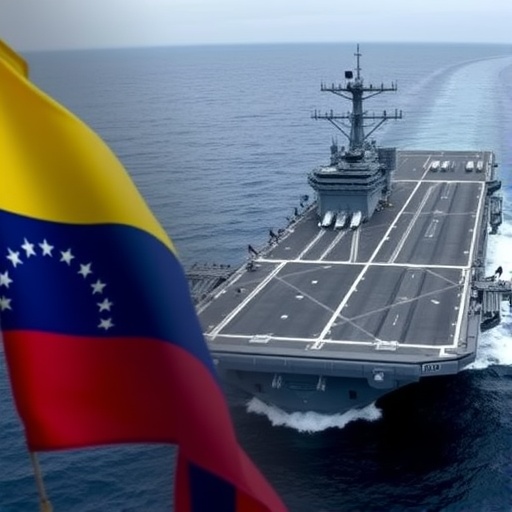Venezuela‘s Maduro Slams US for Fabricating War as USS Gerald R. Ford Aircraft Carrier Steams Toward Borders
In a blistering address that has sent shockwaves through Latin America, Venezuelan President Nicolás Maduro has accused the United States of orchestrating a fabricated war pretext as the mighty USS Gerald R. Ford aircraft carrier edges closer to Venezuelan waters. Speaking from the presidential palace in Caracas on Tuesday, Maduro declared the deployment a “clear act of aggression” aimed at destabilizing his socialist government, escalating long-simmering tensions between Venezuela and the United States.
The USS Gerald R. Ford, the world’s largest and most advanced aircraft carrier, is reportedly conducting routine exercises in the Caribbean, but its proximity to Venezuela‘s coastline has ignited fears of military confrontation. Maduro’s rhetoric, laced with references to imperialism and covert operations, comes amid ongoing U.S. sanctions against his regime and disputes over Venezuela‘s vast oil reserves. “They are manufacturing a conflict to justify invasion,” Maduro thundered to a crowd of supporters, his words broadcast live on state television. This latest salvo underscores the fragile state of bilateral relations, where economic pressures and geopolitical maneuvering collide.
Maduro’s Explosive Accusations Ignite Diplomatic Firestorm
President Nicolás Maduro’s speech was nothing short of a declaration of defiance. Flanked by military generals and waving the Venezuelan flag, he painted a vivid picture of U.S. duplicity. “The empire to the north is once again plotting against our sovereignty,” Maduro stated, directly referencing the aircraft carrier‘s approach as evidence of an impending war. He claimed intelligence reports revealed U.S. plans to stage incidents at sea to provoke retaliation, echoing Cold War-era fears of false flag operations.
This isn’t Maduro’s first rodeo with such claims. Since assuming power in 2013 following Hugo Chávez’s death, he has frequently blamed the United States for Venezuela‘s woes, from hyperinflation to opposition protests. But the timing of this outburst is particularly charged. Just weeks ago, the U.S. State Department announced tightened sanctions on Venezuelan oil exports, citing human rights abuses and electoral fraud in the 2018 presidential vote. Maduro countered by expelling two U.S. diplomats, accusing them of espionage.
Experts note that Maduro’s strategy often rallies his base while seeking sympathy from allies like Russia and China. “It’s classic Maduro—turning external threats into domestic fuel,” said Dr. Maria Gonzalez, a Latin American politics professor at Georgetown University. In his 20-minute address, Maduro quoted Chávez, invoking the Bolivarian Revolution’s resistance to Yankee imperialism. He vowed that Venezuela‘s armed forces, numbering over 120,000 active personnel, stand ready to defend the nation.
The speech drew immediate backlash from Washington. U.S. National Security Advisor Jake Sullivan dismissed the claims as “baseless paranoia,” emphasizing that the aircraft carrier‘s mission supports regional security against narcotics trafficking. Yet, the optics are damning: satellite imagery shared by Venezuelan state media shows the USS Gerald R. Ford, displacing 100,000 tons and carrying up to 75 aircraft, sailing within 200 miles of La Guaira port.
USS Gerald R. Ford’s Power Projection Sparks Regional Alarm
The USS Gerald R. Ford isn’t just any warship; it’s a floating fortress symbolizing American naval supremacy. Commissioned in 2017 at a cost of $13 billion, this nuclear-powered behemoth boasts electromagnetic catapults for faster aircraft launches and advanced stealth features. Its deployment to the Caribbean, part of the U.S. Navy’s Sixth Fleet operations, was officially framed as a training exercise with allies like Colombia and the Dominican Republic.
However, from Caracas’ perspective, the timing couldn’t be worse—or more suspicious. Venezuela has bolstered its own naval presence, deploying frigates and patrol boats along its 2,800-kilometer coastline. Defense Minister Vladimir Padrino López warned that any incursion would trigger a “rapid and decisive response,” hinting at alliances with Iran-supplied drones and Russian S-300 missile systems.
Historical precedents loom large. The United States has a track record of interventions in Latin America, from the 1989 invasion of Panama to support for the 2002 coup attempt against Chávez. Venezuela‘s opposition, led by figures like María Corina Machado, has quietly urged caution, fearing Maduro’s narrative could justify further crackdowns. Meanwhile, oil markets reacted swiftly: Brent crude prices ticked up 2% to $85 per barrel on Wednesday, as traders eyed potential disruptions from the Orinoco Belt, Venezuela‘s key production hub holding 300 billion barrels in reserves.
U.S. military analysts downplay the threat. “The carrier’s presence is routine deterrence, not preparation for war,” asserted retired Admiral James Stavridis, former head of U.S. Southern Command. Still, the ship’s capabilities— including F-35 stealth fighters and Tomahawk missiles—serve as a stark reminder of the asymmetry: Venezuela‘s navy operates aging vessels, many acquired from the Soviet era.
Roots of Rivalry: Decades of US-Venezuela Friction
The current standoff is but the latest chapter in a saga of mistrust dating back to the early 2000s. Under Chávez, Venezuela nationalized oil assets, souring ties with U.S. firms like ExxonMobil, which lost billions in arbitrations. Maduro inherited this antagonism, compounded by the 2019 recognition of opposition leader Juan Guaidó as interim president by the United States and over 50 nations.
Statistics paint a grim picture of the fallout. U.S. sanctions since 2017 have slashed Venezuela‘s GDP by 75%, according to the IMF, fueling a humanitarian crisis with 7.7 million refugees fleeing since 2014. Maduro accuses the United States of economic warfare, pointing to frozen assets worth $130 billion. In retaliation, Venezuela has deepened ties with non-Western powers: Russia provides military advisors, China funds infrastructure, and Iran assists with fuel refining amid gasoline shortages.
Diplomatic cables leaked in 2022 revealed U.S. concerns over Venezuela‘s gold stockpiles being smuggled to fund Hezbollah-linked activities, further straining relations. Maduro’s recent overtures for dialogue— including a proposed meeting with President Biden—were rebuffed, with the White House citing undemocratic practices. “Venezuela is a failed state propped up by authoritarianism,” a State Department spokesperson remarked last month.
Regional bodies like the Organization of American States (OAS) have been paralyzed by the divide. Venezuela withdrew from the OAS in 2019, while the U.S. pushes for investigations into Maduro’s 2024 election rigging claims. Interviews with Venezuelan exiles in Miami reveal widespread anxiety: “Maduro thrives on enemies; this carrier play could unite the world against us,” said one anonymous oil engineer.
Global Powers Weigh In on Brewing Caribbean Crisis
The aircraft carrier incident has drawn international scrutiny, with reactions ranging from condemnation to calls for de-escalation. Russia, Venezuela‘s staunchest ally, decried the U.S. move as “provocative hegemony.” Kremlin spokesperson Dmitry Peskov announced joint naval drills in the Atlantic, involving the Admiral Kuznetsov carrier, signaling Moscow’s commitment to countering NATO influence in the hemisphere.
China, holding $60 billion in Venezuelan debt, urged restraint through its foreign ministry, emphasizing multilateral dialogue via the UN. In a twist, Brazilian President Lula da Silva, a leftist like Maduro, offered to mediate, citing Brazil’s neutral stance post-Bolsonaro. “The Americas must resolve this without external meddling,” Lula tweeted, referencing his own frosty U.S. relations over Amazon policies.
European Union foreign policy chief Josep Borrell expressed concern over potential refugee surges, noting that any war could displace millions across borders. The UN Security Council scheduled an emergency session, where Venezuela‘s ambassador accused the United States of violating international law under the UN Charter’s Article 2(4) on territorial integrity.
Analysts from think tanks like the Council on Foreign Relations warn of broader implications. “This isn’t just bilateral; it’s a proxy for great-power competition,” observed Senior Fellow Shannon O’Neil. Cuba, another U.S. adversary, rallied behind Maduro, with President Miguel Díaz-Canel pledging solidarity against “imperialist threats.” Even neutral Colombia, under President Gustavo Petro, called for naval transparency to avoid misunderstandings.
Pathways to Peace or Peril: What’s Next for US-Venezuela Standoff
As the USS Gerald R. Ford lingers in the region, the world watches for the next move. Diplomatic channels remain open but strained; a backchannel proposal for direct talks between Maduro and U.S. envoy John Kerry was floated last week but stalled over preconditions like freeing political prisoners. Venezuela‘s opposition, fragmented yet vocal, hopes external pressure could force electoral reforms ahead of 2025 midterms.
Economically, the stakes are high. Lifting sanctions could unlock $2 billion in frozen funds for Venezuela, per Brookings Institution estimates, potentially stabilizing the bolívar and easing food shortages affecting 90% of households. Yet, U.S. hawks in Congress, led by Senator Marco Rubio, push for tougher measures, including secondary sanctions on Venezuelan allies.
Military scenarios range from benign patrols to worst-case escalations. The Pentagon has assured no offensive intent, but contingency plans for evacuating 30,000 U.S. citizens in Venezuela are active. Maduro, meanwhile, has ordered nationwide drills, mobilizing 2 million reservists in what he calls “Operation Sovereign Shield.”
Looking ahead, experts predict a delicate balancing act. A thaw could emerge if oil prices soar, incentivizing U.S. imports from Venezuela to offset Russian supplies post-Ukraine invasion. Alternatively, miscalculation—such as a naval skirmish—could spiral into regional chaos, disrupting trade routes vital to global energy. As Maduro’s accusations echo, one thing is clear: the United States and Venezuela stand at a crossroads, where rhetoric meets reality in the shadow of an aircraft carrier.
In the coming days, expect shuttle diplomacy from the likes of the Carter Center, monitoring for human rights progress. For ordinary Venezuelans, weary from blackouts and breadlines, the hope is that words give way to wisdom, averting a war no one truly wants.









